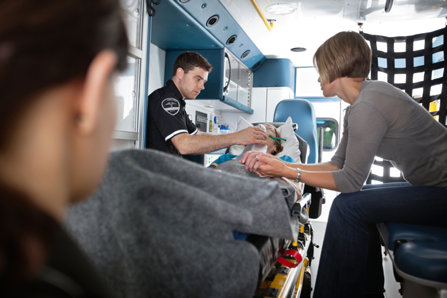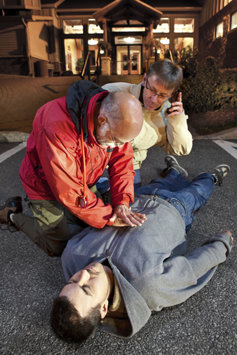What Happens During an Overdose and What Can You Do About It?

I’ve always believed the best way to tackle a problem was to first learn as much about the problem as possible. So when one of my closest friends died from an overdose in 2012, I dedicated a good deal of time and my career to learning about the dangerous phenomenon of overdose. I wanted to help others avoid this life-threatening event.
Along the way, I’ve come to find that most people don’t know what is occurring on a physiological level during an overdose. But in just a few brief paragraphs, I can explain exactly what happens. I hope that you will take this information and use it to prevent overdoses in your own community.
What Takes Place When an Addict Overdoses on Opioids?
The term “overdose” is one of the most commonly used words in the discussion of drug addiction. The word is heard with increasing regularity in the media, and understandably so. Opioid overdose rates climb each year. More people are experiencing this physical emergency. Some survive it; others don’t. The annual and increasing death toll from overdoses has the American people in a frantic search for solutions to the problem.
“Opioids kill people by slowing the rate of breathing
and the depth of breathing.”
But what happens during an opioid overdose? First, the influence of opioids on the brain causes breathing to slow. According to Dr. Andrew Stolbach of the Johns Hopkins University School of Medicine, “Opioids kill people by slowing the rate of breathing and the depth of breathing.”
Opioid chemicals influence the parts of the brain that command the lungs to take in air. When enough opioids are ingested, this influence on the brain becomes overwhelming and eventually leads to a slowdown and complete cessation of breathing.
Next, as breathing slows down, the victim’s heartbeat also slows down. The heart requires oxygen to continue pumping. As oxygen supplies drop and CO2 builds up in the body, the heart rate recedes.
Think of an overdose literally as the body shutting down, and that shutdown occurring primarily because of a slow but gradual reduction in breathing. With that in mind, when one is responding to an overdose, it’s essential to do everything possible to keep the victim breathing.
What Should We Do If We See Someone Overdosing?

According to SAMHSA, these are the steps you should follow when trying to assist an individual who may be suffering from an overdose.
- First, evaluate for signs of an opioid overdose. If you are unable to rouse the individual, call their name loudly and rub your knuckles on their sternum.
- If the person does not wake up, call 911. That way, first responders will be on their way while you are attending to the victim.
- If you have naloxone (the opioid overdose reversal medicine) with you, now would be the time to administer it. If not, you have to attempt to revive the individual by other means.
- Begin rescue breathing. As mentioned earlier, a slow cessation of breathing is what kills a person during an overdose. If you can’t manually wake the person up, begin rescue breathing until help arrives.
- Rescue breathing is simple enough. Ensure the victim’s airway is clear. Tilt their head back. Close their nostrils with one hand. Place your mouth against theirs. Give two slow breaths. Repeat the process with one breath every five seconds — alternating rescue breathing with chest compressions. In doing so, you will, in theory, be forcing oxygen in and out of the person’s lungs.
- The goal is to keep the heart pumping blood, to keep the brain functioning, and to keep the person alive. Once the first responders arrive, they can take over and apply advanced medical techniques to revive and recover the individual.
Responding to an overdose can be a frightening, nerve-wracking experience. But the actual steps to responding to an overdose are quite simple. Just remember that your primary objectives are to:
- Ensure that the overdose victim continues breathing.
- Get the person awake and revived.
- Stay with the person until help arrives.
Help A Family Member, Prevent an Overdose
Seven years into my career of helping people get clean from drug and alcohol addiction, no information I have gathered along the way is as powerful as the lesson I learned the day my friend died. The lesson is that we can save overdose victims in the immediate crisis, but unless we then help them get clean, we will never eliminate the problem of addiction entirely. Saving a life just isn’t enough. It’s likely that an overdosing loved one will go right back to drug use. Will we be there the second time our loved one overdoses? Or the third time?
If you know someone who struggles with drug and alcohol addiction, the absolute best thing you can do for them is to help get them into a drug and alcohol addiction treatment center. That should be your primary focus. Residential drug and alcohol rehabs offer long-term solutions to the immediate, life-threatening crisis of drug and alcohol addiction.
The Narconon Program seeks to help people overcome the physical aspects of their addiction crisis and the spiritual, psychological aspects of their problem as well.
To learn more, take a look at how Narconon helps people find their true, sober, drug-free selves once again.
Sources:
- https://www.sciencenews.org/article/opioid-crisis-overdose-death
- https://store.samhsa.gov/system/files/five-essential-steps-for-first-responders.pdf


 ®
®